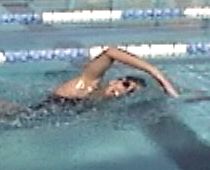 “Do I need to swim with 3-count, or bilateral, breathing?”
“Do I need to swim with 3-count, or bilateral, breathing?”
No.
I’m surprised how many swimmers believe they MUST take three strokes between breaths. It’s just not true.
A 2-count breathing pattern is perfectly acceptable.
2-count breathing means taking two strokes between breaths, thus taking your breath on the same side each time. This does not mean two stroke cycles between breaths. A cycle consists of two individual strokes.
But before I start on the pros and cons of 2-count and 3-count breathing patterns, you will notice that there is no mention below of 4-count, 5-count, or some other higher numbered breathing pattern.
Usually, anything higher than a 3-count breathing pattern is not sustainable for the longer distances found in triathlon swimming events.
And while I’m on the subject, always start with the breathing pattern you intend on keeping. Do not start a race with seven or ten strokes between breaths. You’ll fall behind quickly on the oxygen uptake and this usually doesn’t end well.
So back to 2-count versus 3-count breathing . . .
Technically speaking, 3-count breathing is the more efficient of the two breathing patterns because the head remains in a streamlined position longer. Reducing drag is good, so 3-count breathing must be good, right? Well, if you can sustain it, then yes, 3-count breathing is fine. Go for it. But what happens if you can’t sustain it?
Then 2-count breathing is a sound alternative.
“But everyone says I need to do 3-count breathing!”
Ok, so let’s look at how the fastest swimmers in the world do it.
Cases in point:
- Men’s 1500-meter freestyle final, 2012 London Olympics. Only one swimmer of the final eight used 3-count breathing. Seven swimmers used 2-count breathing. Occasionally, you even see a quick swing breath where there is only one stroke between breaths.
- Women’s 800-meter freestyle final, same Olympics. All eight women used 2-count breathing. Sometimes, you see a quick 2-3 transition, where the swimmer used 2-count breathing, but switched sides mid-pool using 3 strokes between breaths to begin breathing on the other side.
These are just two examples of many where the fastest swimmers in the world use 2-count breathing.
And you know what? It’s ok. If you need the oxygen, you should take it. Period.
PROS OF 2-COUNT BREATHING
- You come to oxygen sooner. This is the biggie. Fulfilling oxygen needs trumps everything!
- Scores of swimmers attempt 3-count breathing, only to fall behind on their oxygen intake, the stroke devolving into a panicked 2-count frenzy with lifting and lurching and who knows what else to get a breath now that they’re behind on their oxygen requirements. Far better to begin with 2-count breathing from the get-go and establish a relaxed, easy breathing pattern that is sustainable.
- A more relaxed stroke
- Given a common stroke rate of one stroke per second, you are only two seconds away from your next breath at any given moment.
CONS OF 2-COUNT BREATHING
- Can lead to an uneven stroke if you only practice breathing to one side
- However, if you always practice right-side breathing traveling in one direction down the length of the pool and return with left-side breathing, you will have practiced each side equally and your stroke will remain even.
- “Limits” field of view in an open water environment
- If you employ proper open water sighting techniques, this is a non-issue.
PROS OF 3-COUNT BREATHING
- Body remains in streamline longer, producing less drag
- The better the swimmer, the less the breathing pattern will factor. Better swimmers create less drag during the process of breathing, rolling more evenly on their longitudinal axes to attain the breath. So breathing more often is of little consequence with respect to creating drag.
- For swimmers with poor breathing mechanics, who lift the head to breathe allowing the hips to drop, or who pull laterally to breathe, pulling their bodies off a straight alignment, having the head down in streamline for a longer period of time is of great benefit.
- Promotes even body roll to both sides
- You can still practice breathing to both sides with 2-count breathing, as explained above, but with 3-count breathing, this even roll to both sides is guaranteed.
- Aids in awareness of positioning in the open water
- Depending on venue, sighting to the sides may be the only thing you need, like if swimming in a narrow channel or river. In this case, 3-count breathing is a great help. Of course, if you’re able to breathe on both sides, even with 2-count breathing, you can switch sides at your leisure for sighting purposes.
- Generally speaking, however, you will still need to sight looking forward to swim the straightest line, regardless of breathing pattern.
CONS OF 3-COUNT BREATHING
- Could be too long between breaths to keep up with oxygen requirements
- Your stroke rate might not be fast enough to accommodate waiting three full strokes until you see air again. If you are determined to swim with a 3-count breathing pattern, try increasing stroke rate, thereby reducing the amount of time between breaths, and this might allow you to do so.
- Intensity level also greatly affects the ability to hold a 3-count breathing pattern. And to be clear, I’m talking about intensity over longer distances, like 200 meters and up, not a 50-meter sprint. At higher intensity efforts, oxygen requirements go up, so the need for a breath sooner often requires a switch to 2-count breathing. If you lower your intensity level, 3-count breathing might be sustainable.


